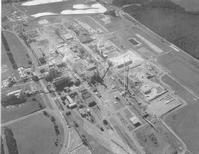


Chapter 4
I Management Of Native Forests
II Plantations-high Productivity Resources
III Protecting The Resource
IV Harvesting The Resource
V Solid Wood And Its Processing
VI Minor Forest Products
VII Reconstituted Wood Products
VIII Pulp And Paper
i Early eucalypt pulping research and development
ii Eucalypt pulp production begins
iii Early commercial operation
iv The beginnings of pulp production from plantation pine
v Technological development and economic growth
vi 1975 and beyond
IX Export Woodchips
X Future Directions
XI Acknowledgements
References
Index
Search
Help
Contact us

1975 and beyond (continued)
APPM first used plantation pine in its pulping operations in 1970 in refiner mechanical pulp production for magazine paper at Wesley Vale, Tas. In the late 1970s it decided to expand its Burnie mill and include some bleached pine soda pulp production. At about this time Honshu Paper in Japan, CIL in Canada and APM[99] all independently discovered that the addition of small amounts of anthraquinone or certain related compounds would significantly accelerate delignification in soda and kraft pulping. APM also found that it had a similar effect in the NSSC pulping of radiata pine and, to a much lesser extent, of eucalypts.[100]APPM had initially considered soda-oxygen pulping for its pulp mill expansion, but with the discovery of the benefits of soda-anthraquinone pulping decided to use this process instead, applying it successfully to mixed radiata pine and eucalypt chips in a continuous countercurrent digester. This enabled APPM to replace imported long fibre chemical pulp on a one for one basis over the full range of its printing and writing papers without deterioration in machine runnability or paper quality -and without the need to instal major new plant.[101] SCI introduced NSSC pine pulping on a small scale in 1973 and later also found it could upgrade this process in terms of both pulp quality and pulping rate by the addition of anthraquinone.
Although it had been pulping radiata pine by the kraft process since the early 1940s, APM still relied heavily on imports, mainly from New Zealand, for most of its long fibre pulp needs. With its extensive Victorian plantations starting to reach maturity, however, it added to its Maryvale operations in late 1983 a large new pine kraft pulp mill with a capacity of 140 000 tonne/yr. The heart of the mill is a state-of-the-art two-vessel vapour phase continuous digester system developed in Sweden and the mill design has emphasized emission avoidance and integrated computer control.[102]

The pulp and paper industry has always been conscious of its environmental responsibilities and recycling of water, chemicals, fibre and paper and the recovery of energy from spent pulping liquor and other wastes have long been part of the technology. On the other hand the extent to which these practices have been economically feasible has depended on scale. As a result, not all these practices were carried out in the smaller mills operating in the earlier years of the industry to the extent which today is regarded as acceptable. This situation has progressively changed as the mills have become larger and, since the early 1970s, tighter environmental controls imposed by governments.
Overseas improvements in chemical recovery technology have now enabled large mills using sulphur-based pulping processes to meet quite stringent limits for gaseous sulphur emissions. One such improvement -black liquor oxidation -was introduced by APM at Maryvale in 1976 and in 1983 a new low-odour recovery furnace was in stalled as part of its pulp mill expansion. In the case of smaller mills using sulphur-based pulping processes it is generally not economical to install chemical recovery systems and so the gaseous emission problem is converted into one of disposing of a liquid effluent with a high sodium and sulphur content. Where the small mill was located close to the sea, such as APM's Port Huon, Tas., NSSC mill or KCA's Apcel sodium bisulphite mill, this did not present a major problem. With SCI's Brooklyn NSSC mill near Melbourne, however, it was necessary to use a combination of municipal sewer disposal and chemical recovery based on a novel overseas NSSC chemical recovery process (Sonoco process) installed in 1976.[103]
Organisations in Australian Science at Work - Australian Paper Manufacturers Ltd (A.P.M.); Australian Pulp and Paper Mills (A.P.P.M.); Kimberly-Clark Australia Pty Ltd (K.C.A.); Smorgan Consolidated Industries Ltd (S.C.I.)
 |
Australian Academy of Technological Sciences and Engineering |  |
© 1988 Print Edition page 241, Online Edition 2000
Published by Australian Science and Technology Heritage Centre, using the Web Academic Resource Publisher
http://www.austehc.unimelb.edu.au/tia/255.html